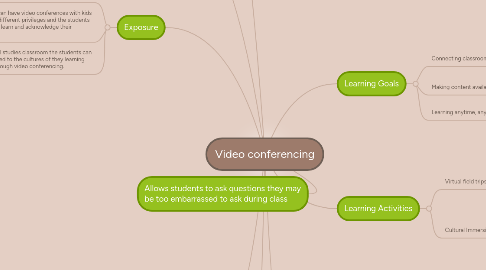
1. Allows students to ask questions they may be too embarrassed to ask during class
2. Teacher Roles
2.1. To research and find resources to help students to meet learning goals
2.1.1. Teachers should provide students with the tools necessary to hold a successful video conference. For example, teacher will work to find experts on a topic to speak with their students
2.1.2. It is the teacher's responsibility to gather the necessary technology and to test it prior to student use. Teachers should also be familiar with whatever application is being used, should any problem arise during the conference.
2.2. To facilitate a meaningful conversation
2.2.1. Teachers should tie the information gathered in the video conference to the curriculum, moving towards a larger learning goal
2.2.2. Provide students with guided questions and ideas to guide their learning throughout the conference
2.3. Regulate Conference
2.3.1. Teachers should make sure students are on task and conducting themselves in a professional manner.
3. Learning Assessment
3.1. Self Reflection Paper
3.1.1. Post video conference, have students complete a somewhat, structured self-reflection assessment. In this assessment, students will share what they learned from the vieo conference experience and what they still wish to learn.
3.2. Assessment Specific to topic
3.2.1. For example, students in a home economics class may video conference a chef and watch them make a certain dish. Afterwards, students will be tested on the steps in making and preparing the dish.
3.3. Formative Assessment
3.3.1. Assess student's various skills throughout the conference. Skills they will be tested on would include communication skills and ability to engage in the conference. Teachers could use a rubric to assess if students met the learning objective.
4. Exposure
4.1. Kids can have conversations with students from different cultures
4.2. Students can have video conferences with kids that have different privileges and the students are able to learn and acknowledge their privileges.
4.3. In a social studies classroom the students can be exposed to the cultures of they learning about through video conferencing.
5. Experience
5.1. Students will have experience with video conferences for when they grow up and have the experience using this tool.
5.2. With technology constantly changing and businesses picking up on the technology students can be prepared and up to date on the latest form of technology they use.
5.3. It's a good experience for students because they will have practice talking to a crowd of people via video conferencing.
6. Possible Lessons/ Video Conferencing Ideas
6.1. Famous Missourian Mystery Game
6.1.1. In elementary schools in Missouri, students choose a famous Missourian in history to research. Students could Skype or video conference a classroom at another school that also did the famous Missourian research. Students from both classrooms would act as there famous Missourian, taking turns to present the conference with clues as to their "identity". Students will take turns guessing.
6.1.1.1. Works as a fun activity for students to reward their handwork on research. Also allows to students to further their knowledge of famous Missourians by learning about ones other then the person they chose to research.
6.2. Medical Lab/ Surgery Observation
6.2.1. Students in biology and anatomy classes can video conference with actual medical professionals and watch them perform surgeries and other procedures.
6.2.1.1. Allows students to visualize body processes and to gain a better understanding of them
6.3. Can be used in a social studies classroom
6.3.1. Can do visual pen pals with children from different countries.
6.4. Virtual Career Fair
6.4.1. Highschool students with an opportunity to talk to various professionals around the world and gain insight to what those careers may entail.
7. Gives visual learning with real time results with collaboration
7.1. Allows a different learning style for students who do not quite get everything in the class
8. Learning Goals
8.1. Connecting classrooms around the world
8.1.1. Allows students to collaborate with students from different countries to help create a better idea of how things are in other parts of the world.
8.2. Making content available everywhere
8.2.1. Making summer school possible anywhere.
8.3. Learning anytime, anywhere
8.3.1. Great for homeschooled kids who need help on certain topics. Who do better with human interaction via webcam
9. Learning Activities
9.1. Virtual field trips
9.1.1. Connects classrooms around the world
9.1.2. Allows for a different style of classroom atmosphere to help enhance learning.
9.2. Cultural Immersion
9.2.1. With video conferencing, students can "travel" to various places around the world.
9.2.1.1. For example, a high school French class in the United States can learn about education in France by video conferencing with a classroom in France. This would offer students an opportunity to expand their horizons and improve their French skills
